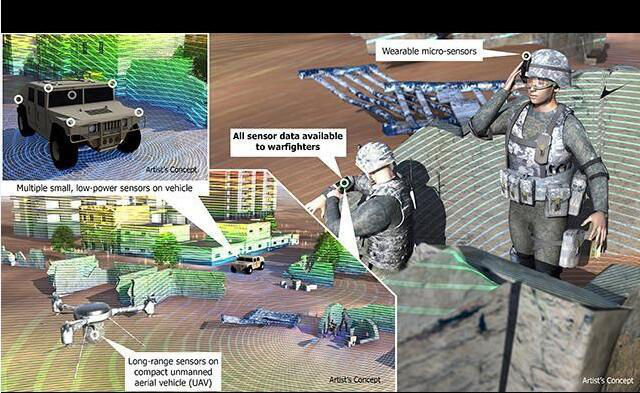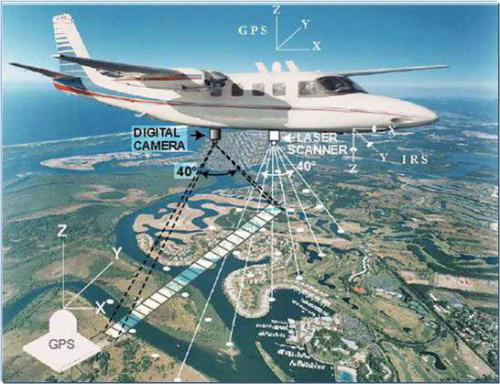Laser radar technology has been applied to military, production, life in all areas, and truly benefit the military and civilian. Lidars in a variety of forms, technical indicators and technical methods will be with the device level and processing level updates and update. Lidar is very versatile and is a viable method of detection, since it is possible to obtain the distance information of the target relatively accurately, without any alternative. Infrared passive detection cannot get the distance, microwave detection distance accuracy is not high.

1 Microscopic principle of laser production - stimulated radiation
The stimulated radiation is the impact of the photon with the frequency of (e2-e1) / h, which causes the particle to transition from the low energy and high energy level with a certain probability, and this process will release a polarization state, the phase and frequency are different from other Photons are exactly the same photons. The interaction between the particles and the light can interact with each other, and the interaction between them is manifested in the absorption and radiation of the photons that are used to form the microscopic particles of the substance, thereby triggering changes in their own state of motion. This interaction refers to the interaction of particles between two different energy levels, their frequency is ν = ΔE / Planck constant, and the energy difference is ΔE, the particles in each microscopic state are in a A particular state has its own set of levels, and the state of their existence must be a single state and can be understood as the only state of their existence at any time.
1.1 stimulated absorption
The definition of stimulated absorption is to absorb energy, the low energy level to the high energy level transition, in the process, for the absorption of the requirements, and in the collision with the photon occurred when it should be inelastic, that is, through the outside world after the incentive , Low energy level to high energy level transition.
1.2 spontaneous emission
The particle has a certain probability, spontaneously from the high energy level excited state (E2) to the low energy level, and the particle has a certain probability, even if there is no external effect, (E1) transition, while the radiation of the energy (E2-E1) photon, photon frequency ν = (E2-E1) / h. This radiation process is called spontaneous emission.
The laser is mainly produced by the stimulated emission of atoms at a high energy level excited by a photon excited by ν = (E2-E1) / h, and then the two photons are obtained. And then re-energize the high-energy level of the atoms, get multiplied photons, so the beginning of the weak concern was increased a lot. The laser is produced in this process. The difference between the laser and the ordinary light The frequency, phase (cohomology) of the photon in the light, the direction of the forward is different. All photons in the laser have the same frequency, phase (cohomology), forward direction, in addition to laser or coherent light. Laser with; high brightness, good direction, good monochrome, good coherence four characteristics.
The Formation and Principle of Laser Radar
The receiver system of the direct-type detection lidar receives the signal from the transmitting system. According to this principle, it can be used for ranging, and the distance from the signal propagation is calculated.
Lidars can be divided into pulsed laser radar and continuous wave laser radar according to their working methods. According to the different detection technology, the lidar can be divided into: direct detection type lidar and coherent detection type lidar, according to the application range can be divided into: (Guidance, investigation, warning, underwater target detection), laser radar guidance (spacecraft interfacing docking, obstacle avoidance), laser radar, radar, laser, radar, laser, radar, Atmospheric measurement of laser radar (cloud height, atmospheric visibility, wind speed, atmospheric composition and content of the material). LIDAR is mainly used in tracking, imaging guidance, three-dimensional visual system, wind measurement, atmospheric environmental monitoring, active remote sensing and other direction.
2.1 Selection of lasers
We choose the principle of the laser is mainly based on frequency, durability, reliability, cost and applicability and other aspects of consideration, semiconductor lasers meet the above requirements. Semiconductor lasers with the characteristics of coherence are not high, for the direct and indirect type of detection options, is undoubtedly to choose a direct type. There are two types of probing for direct probing. First, the pulse type, its principle is based on the narrow pulse to record the laser to reach the destination of the time, by measuring the time, using the formula R = 1 / 2CT to calculate the starting point to the end of the distance. Where C is the speed of light, F is the round trip time, and the distance is R. Second, continuous type, its principle is based on the principle of the phase difference. It is through the continuous laser scanning at the beginning and end of the scan before, that is, through the start and end of the laser phase difference and then calculate the distance between the two. By comparing continuous and pulsed types, we find that they all have advantages and disadvantages, but there are shortcomings in the continuum that are difficult to operate and time-consuming, so we rarely use this approach.
In summary, we chose the semiconductor pulse laser.
2.2 Laser Radar for imaging methods
It has been found that there are three methods for imaging a lidar, including the detector and the array. For the unit type, its detection range is relatively small, its scanning method is through the existing scanning samples to the destination of the location, its scanning results are mainly divided from the target point of view to the angle to the distance The way and from the angle to the angle to the intensity of the two ways of measuring the image. For a face array, its measurement range includes each pixel. In the laser radar imaging technology is mainly space scanning and phase space scanning, which uses no space scanning laser radar scanning methods are generally double wedge, oval, mirror and galvanometer four scanning methods. The third scanning method is the optical machine scan, its scanning method mainly exists in the material space. After a large number of scientific experiments and exploration, and finally found the unit type of detection methods, more in line with the expected results of the study and also better to achieve, for the strength and distance image measurement, unit type measurement method requires a laser scanner to measure.
3 lidar application
LIDAR technology has become a strategic technology of various countries Xingguo Bang, China's laser radar technology in recent years has also made breakthrough progress, such as by the China Aerospace Science and Technology Corporation five homes 508 laser engineering technology research laboratory developed multi-channel Photon counting system of laser radar prototype prototype recently completed the day and night field test, marking the laser detection technology in China to a higher level. And recently, synthetic aperture laser radar SAL technology development, it is possible to make human with "clairvoyance" ability. The realization of this technology is also a major breakthrough.



